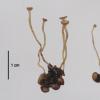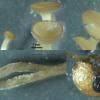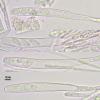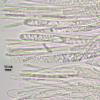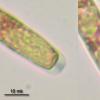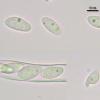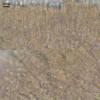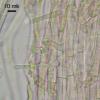
22-12-2025 00:47
Patrice TANCHAUDBonsoir, récolte à proximité du milieu dunaire

21-12-2025 21:32
Pol DebaenstHello, Garden, Burgweg 19, Veurne, BelgiumOn 10/1

21-12-2025 21:40
Isabelle CharissouBonjour, j'aimerais connaitre les références de

21-12-2025 21:31
Pol DebaenstHello, Garden, Burgweg 19, Veurne, BelgiumOn 10/1

21-12-2025 21:31
Pol DebaenstHello, Garden, Burgweg 19, Veurne, BelgiumOn 10/1

20-12-2025 23:08
Patrice TANCHAUDBonsoir, récolte sur sol sablonneux dans l'arri�

21-12-2025 09:32
Hello.A tiny ascomycete found embedded in wood in

20-12-2025 15:47
Mirek GrycHi.These grew on pine wood that was heavily covere
Apothecia cupulate with long stipe, up to 2.5 cm long, disc 2.5 mm across, light brown, hymenium light yellowish-brown, upper part of stipe pubsecent under lens, arise from short cylindric sclerotia, 5 apothecia collected from one old berry, sclerotia attached to seeds.
Asci cylindrical with narrowed base, with crozier, with euamyloid ring, 4-spored (but irregularly one to 6-spored asci seen, with part of spores abrupt, many of asci were also underdeveloped and empty), 108-119 x 9.5-11.3 mk; paraphyses cylindrical, moderately branched, with many small greenish guttules, 2.4-3.7 mk broad in upper part; spores ellipsoid, inequilateral, with two small guttules at both ends, 13.1-15.5 x 6-7.5 mk (n=7, only large not abrupt spores measured).


Rutstroemia chamaemori
Ciboria latipes
Sclerotinia tetraspora
all with a similar spore size.
Did you compare all three? I do not know either of them but I suspect you are right with Sclerotinia tetraspora, because latipes does not fit and R. cham. is on leaves.
But I wonder about the excipulum. Your photo shows only the cortex of very small globose cells. Are they larger inside?
Zotto
The species has distinct scletorium (not stromatized tissues or black stroma), which points to the genus Sclerotinia.
I have seen Rutstroemia chamaemori on this plant (likely, but spores were curved which is not mentioned in descriptions) and showed it here before. http://www.ascofrance.com/search_forum/24922
Ciboria latipes - i have not met, but according to the key in Nordic Macromycetes (2000) it should have stromatized host tissues instead of a distinct sclerotium. Is it right?
I have microscopied excipulum once more, it is made from such small cells in upper part, no larger cells inside. Most inner tissue (medulla) made from interwoven hyphae. Cells become some larger at the base of receptacle. Probably the apothecia were also young, as many asci were underdeveloped.

The VBs in the paraphyses would point to a Botryotinia, by the way.

